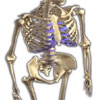- What is Osteoporosis
- Statistics on Osteoporosis
- Risk Factors for Osteoporosis
- Progression of Osteoporosis
- Symptoms of Osteoporosis
- Clinical Examination of Osteoporosis
- How is Osteoporosis Diagnosed?
- Prognosis of Osteoporosis
- How is Osteoporosis Treated?
- Osteoporosis References
What is Osteoporosis
Osteoporosis is characterised by reduced bone mass and deterioration of bone architecture, resulting in bone fragility and subsequently increased risk of fractures. With osteoporosis the bone is normal in composition, but deficient in quantity, quality and structural integrity.
Statistics on Osteoporosis
Osteoporosis is a common problem worldwide – it is thought that 1 in 3 women and 1 in 8 men worldwide are affected. The lifetime risk of hip fracture for a caucasian female or male aged 50 years is 15% and 5% respectively. 30% of women and 15% of men aged 80 years or older will experience a hip fracture.
Risk Factors for Osteoporosis
Osteoporosis has many contributing factors. These include age, sex, genetics, nutrition and lifestyle.
- Osteoporosis is much more common in older persons.
- Being Caucasian or Asian, and female increases the risk of osteoporotic fractures.
- Genetic factors are involved. A family history of osteoporosis increases risk, as does a history of connective tissue disorders such as Marfan’s syndrome or osteogenesis imperfecta.
- Dietary factors: increasing the dairy intake of adolescents has been shown to improve bone mineralization. However a balanced diet is essential. For instance phosphorus is a component of carbonated drinks, and high phosphorus intake compromises calcium uptake, thereby promoting decreased bone mass. Eating disorders such as anorexia nervosa also compromise bone density.
- Lifestyle factors are also important. A sedentary lifestyle and immobility increase the risk of osteoporosis. Cigarette Smoking and excessive alcohol consumption have been shown to have negative effects on bone mass. Certain medications may also have negative effects on bone mineral density.
Progression of Osteoporosis
Osteoporosis may be divided into types I and II. Secondary osteoporosis also is called type III.
- Type I, or postmenopausal, osteoporosis is thought to result from deficiency of sex hormones (oestrogen, testosterone), resulting in accelerated bone loss.
- Type II, or age-related osteoporosis, occurs in both women and men due to decreased formation of bone occuring later in life. This results in a a more fragile bone structure and increased risk of fractures of the hip, long bones, and vertebrae.
- Type III osteoporosis usually occurs due to medications, endocrine disorders (eg. Cushing’s), excessive alcohol intake, smoking, cancer and GIT disorders (due to malabsorption).
How is Osteoporosis Diagnosed?
A complete history and physical examination is important to exclude underlying causes of osteoporosis. Fracture risk should be assessed based on likelihood of falls, low bone density and previous fractures. X-rays usually show fractures if present, and may show evidence of past undiagnosed vertebral fractures. Bone mineral density scans are the most commonly used test to measure bone density and assess fracture risk.
Prognosis of Osteoporosis
Fractures due to osteoporosis can cause significant disability and a reduced quality of life to those affected. Prevention of osteoporosis in young people is important, as is screening for the condition in people at risk so that further bone loss may be prevented.
How is Osteoporosis Treated?
Lifestyle changes may be suggested – weight bearing exercises, quitting smoking and increasing calcium in the diet.
Physiotherapy and occupational therapy may help improve safety and mobility at home.
In terms of osteoporosis medications, most patients are prescribed vitamin D and calcium supplements. Patients who have had fractures in the past may be started on medications called bisphosphonates eg. Fosamax, which helps to prevent bone loss. A new class of medications called selective estrogen receptor modulators are currently being studied in the treatment of osteoporosis.
More information
 |
For more information on osteoporosis, including its effect on bones and the importance of nutrition and dairy, as well as some useful videos and tools, see Osteoporosis. |
Osteoporosis References
- Apley G. Concise system of orthopaedics and fractures. 2nd ed. 2001, Arnold
- Collier, Longmore, Scally. Oxford handbook of clinical specialties, 6th ed. 2003, Oxford University Press.
- Kumar and Clark. Clinical Medicine 5th ed. 2002. WB Saunders
- Nguyen, Center, Eisman. Bone and Joint Disorders: Prevention and Control. Osteoporosis: underrated, underdiagnosed and undertreated. MJA 2004; 180 (5 Suppl): S18-S22.
- South-Paul J. Osteoporosis: Part I. Evaluation and Assessment. Am F Phys 2001. (online) http://www.aafp.org/afp/20010301/897.html
- South-Paul J. Osteoporosis: Part II. Nonpharmacologic and Pharmacologic Treatment. Am F Phys 2001. (online) http://www.aafp.org/afp/20010315/1121.html
All content and media on the HealthEngine Blog is created and published online for informational purposes only. It is not intended to be a substitute for professional medical advice and should not be relied on as health or personal advice. Always seek the guidance of your doctor or other qualified health professional with any questions you may have regarding your health or a medical condition. Never disregard the advice of a medical professional, or delay in seeking it because of something you have read on this Website. If you think you may have a medical emergency, call your doctor, go to the nearest hospital emergency department, or call the emergency services immediately.







